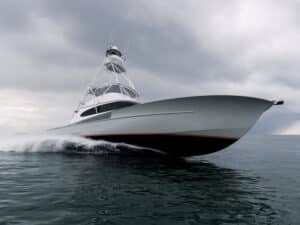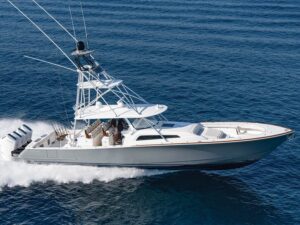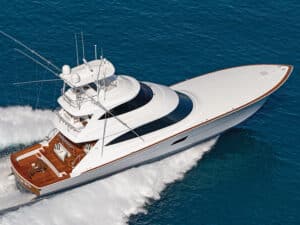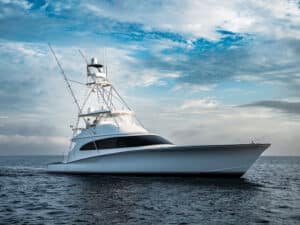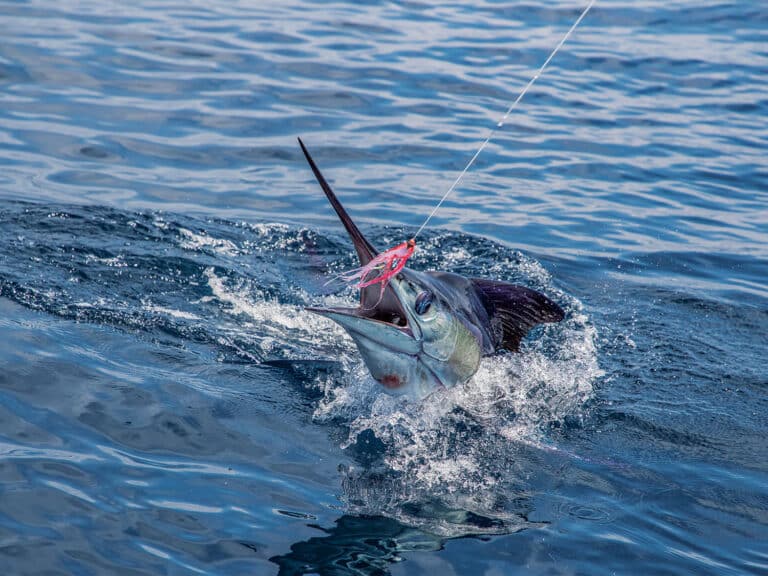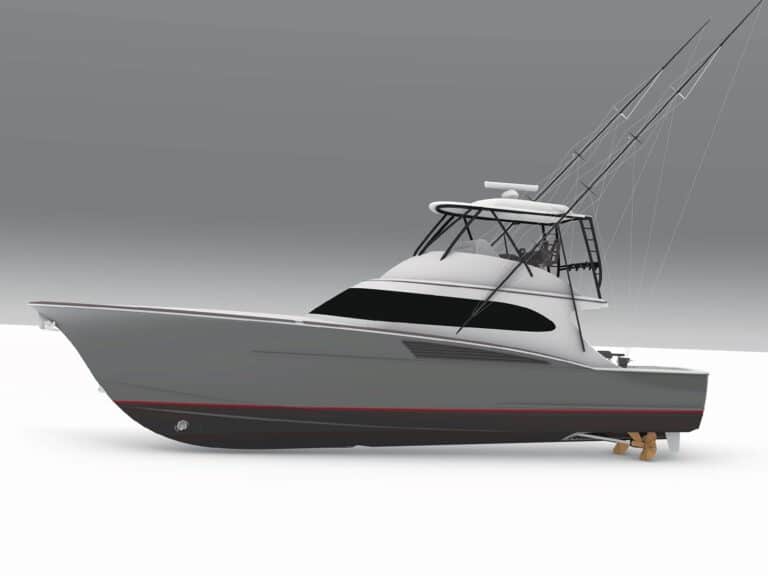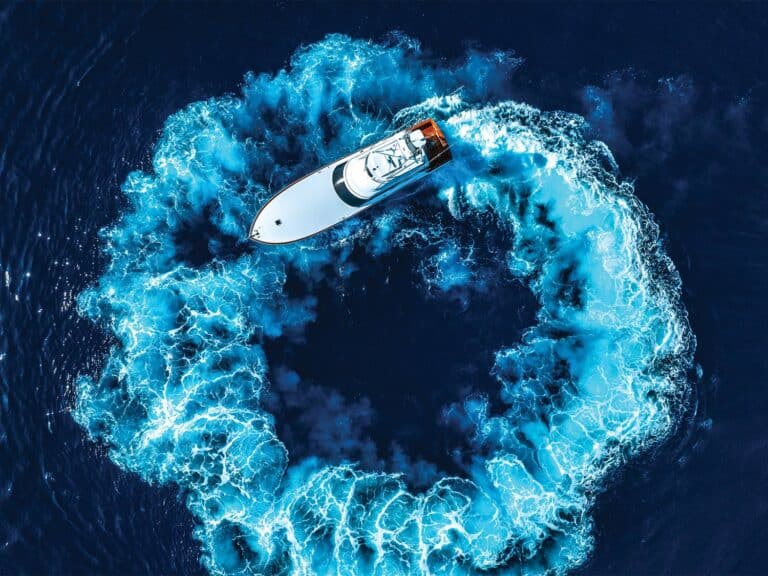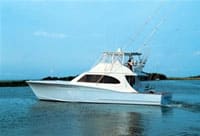
Spenser 57_03
Born and bred on the Outer Banks of North Carolina, Paul Spencer knows firsthand how rough and treacherous local waters can be. And after several years in the charter business, he also knows that for a man to make a living fishing here, he has to be able to go to sea on days when most crews find it prudent to stay home. When I first took a boat to Hatteras to participate in the rugged wintertime Bluefin tuna fishery, I would get up at first light and look out the window of my apartment that over looked the marina. If Spencer’s charter boat, Sizzler, was still in its slip in the marina, chances were good that I’d get to sleep in that morning because of nasty weather.
Spencer’s father-in-law built the Sizzler, which had a good reputation as a sea-kindly boat but lacked the speed of a newer craft. To keep a competitive edge, Spencer needed a new ride. Like so many other Outer Banks skippers who, since boyhood, had run boats, repaired boats and helped other men build boats, he decided he needed to build a new boat for himself. He credits earlier Outer Banks boat builders, including Sheldon Midgett, for revolutionizing boat construction and design, and he intended to follow their lead and take the process even further when building his own.
“I watched North Carolina charter boats evolve, getting faster and better built. I thought I could add to the earlier improvements. I was motivated to build not only a faster boat, but also a better sea boa,” says Spencer. “I like the strength of cold-molded wooden boats. Water gets real hard as you go faster. You need a strong boat to run fast in the kind of seas we fish. Sometimes we run 100 miles to get to the fish. But just as important to me, I wanted my boat to look good.”
He must have hit that goal because before he could even finish the new boat, Spencer got an offer he couldn’t refuse to sell her– based solely on the way the boat looked. Folks could see she would perform well in a sea. His problem was that he had already sold his old boat and had charters booked for that summer. He didn’t want to let his loyal customers down. He finally agreed to sell the new boat, subject to his being able to fish her that summer before handing her over to her owner-to-be. By the time summer was over, the boat’s looks, and her performance, had generated two more orders for craft just like her. Spencer built a second shed so he could build two boats. When he got a third order for yet another boat, he built a third shed. He started building all three boats simultaneously and has never gone back into the full-time charter business.
I was fortunate enough to fish one day of the recent Big Rock Tournament in Morehead City, North Carolina, with Capt. Paul Spencer and his friend and client Bill Blount on Blount’s newly launched 58-footer Barbara B. Both Blount and Spencer had described Barbara B to me as being a plain vanilla fishing machine. Talk about a classic understatement! The Spencer crew did a fantastic job finishing this boat inside and out.
The engines on Barbara B, twin 1,000-hp C-18 Caterpillars coupled to ZF 550 marine gears, are modest by today’s standards. Even so, when Spencer got news of a flurry of marlin bites around noon, he was able to cruise over to the hot spot at a smooth 31knots without using more rpm than the manufacturer’s recommended extended cruising limits.
But the ride is the main reason Paul Spencer boats represent the hot ticket in town. The day I was aboard there was a bit of left over swell from the brisk winds of the day before. One passenger fell asleep in the big queen bunk in the forward cabin as we left the dock — and never bothered to move aft when we cleared the jetties and headed offshore at an economical cruising speed of29 knots. Staying all the way forward is not recommended in any boat on a really rough day, but it was impressive to have someone sleep up there even in moderate seas.
Clean simplicity and functionality marked the flying bridge. When I stuck my head above the hardtop, Spencer thought I was yearning for a tower to get a higher vantage point so I could watch the baits. But I was only trying to see how he had fabricated the elegantly clean and simple teaser reel holder. The holder consisted of two reel seats welded together with some anodized aluminum pipe, with a piece of threaded plate welded into the end of the pipe to receive a bolt from above. Nothing projected below the hardtop but a clean, functional and attractive piece of aluminum pipe with two reels in the reel seats. I found this same attention to detail and functionality throughout the vessel.
Flybridge
The bridge console itself was molded fiberglass with an elegant, curved shapeliness that I had never seen done before. No wood and no varnish, but beautiful — my kind of boat. All the dimensions were just right with both the steering wheel and single-lever controls set at convenient, comfortable heights for running, trolling or in close quarters at the dock. The access hatch from the bridge to the lower deck fit flush into the bridge sole, a clean and simple safety feature. The hatch sported a pair of pressurized actuators that helped lift it from underneath and settled it gently back into place. The aluminum access ladder going below was powder-coated and painted with white Awl grip. Spencer packed a ton of dry storage on the bridge. The settees, the control and electronic console, and a large cavity up front all had utilitarian storage spaces underneath. You’ll never have too much storage space on a boat, and Spencer provides as much as he can.
The most dramatic feature of the cockpit was the complete lack of hatches in the deck. Access to the aft lazarette, the steering gear, bilge pumps and fuel tank crossover valves comes via a crawlway from the engine room between the fuel tanks and under the cockpit deck.
“I have never seen a hatch that didn’t leak to some extent when backing down on big fish,” Spencer said. “This keeps that whole area clean and dry.”
An easy-opening, watertight door could easily be installed between the tanks to isolate the aft lazarette from the engine room compartment. I think I would probably request such a door. A large percentage of any serious problems that cause compartment flooding involve rudders or propeller shaft struts. I like to know the engine room can stay dry and keep the machinery functioning even with a major collision and holing in the aft compartment.
Cockpit
** **The cockpit was eminently fishable. I loved the plethora of rod holders: There were four in each side covering board, two in the transom covering board, four in a rocket launcher behind the chair and two in each side armrest of the fighting chair. Six more rod holders were mounted on the belly rail on the bridge. Carolina anglers and crews fish for a large variety of species and can easily use two dozen different rods in the course of a fishing day. There is no such thing as too many rod holders.
There were comfortable, shaded seats for the crew and anglers on top of two insulated boxes for bait and drinks, which were supplied from another box that received ice from an Eskimo ice maker below decks in the engine room. And built into the transom was a large kill box that received a nice-sized dolphin as we fished along a weed line.
If it were my boat, I would have installed an offset stanchion on the fighting chair to better clear the corners of the transom covering boards when using maximum drag settings on big, dogged game fish. (Deeply bent rods become significantly shorter and will not clear the corners as easily.) The way I fight fish, I need to be able to easily clear the cockpit corners with the rod tip. I asked where the gaffs were stored, then felt a bit foolish when all I had to do was bend over and look up. The gaffs were hidden, in plain view, under the covering boards. There were no fittings easily visible to spoil the clean and sparkling finish of the outboard cockpit side panels.
Engine Room
The engine room sparkled like a gem glossy white Awl grip paint. All the basic preventative-maintenance necessities were inboard of the engines and easy to hand. Instead of using a plumbed-in oil-change system, Spencer offers an easy-to-lift pump with quick-connect fittings mounted just aft of the access hatch.
Spencer also fills the space between the engine stringers with high-density foam and glasses it over to provide an easy-to-clean walkway between the engines. The laminated fir stringers are capped with powder-coated aluminum. For added structural integrity, the boat boasts seven full-length longitudinal supports, including chines, keel, and inboard and outboard engine stringers.
Fittings fastened to the side of the gleaming white tanks allow you to hang your rigged flying gaffs. The gaffs are constantly ready for quick use but out of the way until actually needed. The tanks also have easy-to-see-and-read sight gauges for instant assessment of fuel levels.
Another interesting feature found in the aft lazarette is a custom-built trim tab arrangement. An electric 2,000-pound actuator with a 3-inch stroke pushes a 1-inch stainless-steel shaft into the middle of a stainless-steel plate. Coupled with a heavy-duty hinge at the forward end, this system eliminated the problems Spencer previously had with off-the-shelf tabs.
Interior
The Blounts describe Barbara B as a simple fishing boat, but her two staterooms and crews quarters are lovely and well-designed with interesting features everywhere. In the interest of comfort, all air-conditioning ducts blow indirectly through soffits so they won’t create cold spots and drafts of chilly air.

The interior comes well appointed with first-class joinery and beautiful cherry wood cabinetry. The flat panel TV in the master stateroom hides behind a one-way mirror opposite the foot of the thwart-ship, queen-size bunk. When the TV is off, it’s virtually invisible.
The master stateroom head and shower are located forward for added privacy. Both the guest stateroom with a full-size and a three-quarter bunk and the crew’s cabin with two single bunks make optimum use of available space. Spencer made good use out of every available inch of interior space, providing as much storage as humanly possible, a feature that will make cruising to Mexico or the Bahamas much more enjoyable for her owners and crew.
While we might not have caught much the day I was on board, there’s no doubt the Barbara B raises more than her share offish. In every previous tournament fished on this boat, the Blount family managed to catch a blue marlin.
They got a blue in the Hatteras Village Tournament, won there lease division and finished second overall in the Rotary Tournament, wound up tied for first in the Big Rock release division (catching the winning dolphin as well), and came in second overall in the Hatteras Marlin Club Invitational. They are currently leading in the North Carolina Governor’s Cup race. What better endorsement for a fishing boat could you ask for?
Specifications
LOA 57′
BEAM 16’10”
DRAFT 52″
DISP. 47,000 pounds
FUEL 1,000 gallons
WATER 225 gallons
POWER Twin/C-18, Cats 1,000-hp
PRICE N/A
Spencer Yachts
252-473-6567
www.spenceryachtsinc.com
